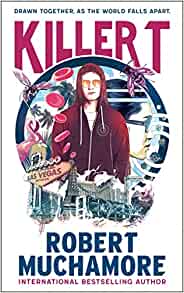 Killer T, by Robert Muchamore (Hot Key Books, 2018)
Killer T, by Robert Muchamore (Hot Key Books, 2018)
Robert Muchamore isn’t known for writing sf, but it’s no surprise to be reviewing him because evidence to hand suggests he has an sfnal mind. He is best known for the CHERUB books, a witty and enjoyable YA series about a section of British Intelligence that solely uses child agents. CHERUB is described with a geekish attention to detail, structured and run by adults with appropriately consistent procedures and levels of hierarchy such that you can actually believe, if CHERUB existed, it would exist like this.
Muchamore’s kids can be your best friend and their own worst enemy. They swear, get drunk, have sex, misbehave, can be amazingly brave and deeply vulnerable, and generally act like real teenagers. And Muchamore isn’t averse to occasionally killing off a main character, quite by surprise and even from the character’s own viewpoint.
All of which happens in Killer T, his first sf title and standalone novel.
The sf is well hidden in Part 1 as we meet the two main characters – Harry, an ex-pat Brit kid at a Las Vegas high school, and Charlie, a girl sentenced by fate to a life of trailer-trashdom. So far, so teen-drama, though the inherent likeability that any adult will find in a teenager they get to know well keeps the reader going. Then comes the first surprise, a hard decision leading to an enforced two-year break before Part 2. During those two years, the first of the bioplagues strikes, and nothing is ever quite the same again.
Now we come to see why Muchamore chose Vegas as a setting – apart from the obvious of wanting to catch the US audience. (I’ve no idea if an actual American will find it convincing, but it worked for me; and a CHERUB novel also featured Vegas heavily, so it may well be somewhere he actually knows.) It’s an isolated outpost in the middle of a desert, so can ride out the worst effects of the global plagues, though not unscathed, and also serves as a handy authorial close-up of the global scene. There are more plagues to come, each one bioengineered, sometimes by governments and sometimes by bored kids in a back room. Muchamore knows his human nature all too well. The story continues in leaps of two or three years until Charlie and Harry are in their late twenties. More plagues come, each with nastier effects.
And life goes on, which is where Killer T really scores. There’s no totalitarian government arising from the ashes, no post-apocalyptic scenario begging for a movie franchise. Society is hit hard by the plagues – but it persists, as it did after the Black Death: both in a recognisable from to what it was before but also never the same again. Each time, the world just shifts onto a new course. This is only a slightly post-apocalyptic world, and thanks to modern communications it retains the knowledge that it has always had. Sadly, that knowledge includes how to splice genes in a garage somewhere as easily as a present day teenager can hack an account.
So, from some points of view, Killer T may be on the borderline between sf and technothriller. The plagues are not just arbitrarily described, but plausibly backed up with biological research and extrapolation. The eponymous deadliest plague gets its name because it hijacks the body’s killer-T cells, which normally produce antibodies, and turns them into virus factories. But I say sf, because – a bit like my favourite plague novel, Earth Abides (in which the effects of plague are much, much worse) – this isn’t so much about the plagues as an intelligent exploration of their effects, and above all about humanity persevering. If nothing else, give it to your own teens because unlike other dystopian YA series, it teaches them about being human and it gives hope.
